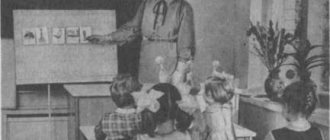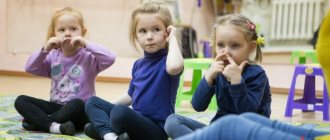Nadezhda Matveeva
Exercises to develop phonemic awareness
Exercises to develop phonemic awareness.
phonetically clear speech in children It is possible to prepare a child well for school and create the basis for learning to read and write only through serious work on the development of phonemic awareness .
Professor R. E. Levina, within the framework of the psychological and pedagogical classification of speech disorders, identified a group of children with phonetic-phonemic underdevelopment of speech (FFN)
.
These include children with normal physical hearing and intelligence, who have impaired pronunciation and special phonemic hearing .
What is phonemic awareness and phonemic awareness ?
Phonemic hearing is a subtle , systematized hearing that allows you to distinguish and recognize phonemes of your native language . Being part of physiological hearing, it is aimed at correlating and comparing audible sounds with their standards.
The concept of “ phonemic hearing ”
should be distinguished from the concept of
“
phonemic awareness ” .
normally developing child hears the sounds of the surrounding world, sees the articulatory movements of adults and tries to imitate them. At the same time, the child is faced with different sounds of phonemes of his native language : the same sounds are pronounced differently by adults and children, men and women. But these sound shades do not serve to distinguish the sound shells of linguistic units.
According to N.I. Zhinkin, the signs of sound include the encoding processes themselves, which occur during the transition of a signal from the periphery of the nervous system to the center.
It has been established that already at the early stages development , the child picks up some differential features of phonemes . A three-year-old child may not yet pronounce the sounds of his native language correctly, but he is able to determine whether they sound correctly in the speech of others. This phenomenon is possible due to the presence of phonemic hearing and phonemic perception .
Phonemic awareness is the ability to distinguish phonemes and determine the sound composition of a word. How many syllables are in a word? How many sounds are there in a word? What consonant sound comes at the end of a word? What is the vowel sound in the middle of a word? It is phonemic awareness that helps answer these questions.
Work on the formation of phonemic perception involves the following sequence:
• At the first stage of teaching sound analysis, the vowel sounds a, u, i are used. Children determine the first vowel sound at the beginning of a word, the sequence of vowel sounds (for example, ay - 1st a; 2nd - y)
.
• Next, the analysis and synthesis of the reverse syllable type an, ut is carried out. Children learn to isolate a consonant from the end of a word (cat, poppy)
.
They then proceed to isolate the initial consonants and stressed vowels from the position after the consonants (home, there)
.
• Next, children master the analysis and synthesis of a direct syllable like sa. Children learn to divide a word into syllables and make diagrams.
• Then children master a complete sound-syllable analysis of monosyllabic three-sound (poppy)
and two-syllable
(goat)
words and make up corresponding diagrams.
• Further complication of the material involves the analysis of words with a combination of consonants (table, trisyllabic (ditch)
.Terms are learned: syllable, consonant sounds, dull, hard, soft sounds.
• At the same time, children become familiar with letters, which are then combined into syllables. It is important that from the very first exercises, you should strive to ensure that the child reads syllables. It is necessary to ensure that children understand the words and sentences read.
Examples of practical tasks and games for the development of phonemic hearing , perception , auditory attention and memory.
“If you hear it, clap”
.
Goals: develop auditory attention , phonemic perception .
Progress of the game. An adult pronounces a series of sounds (syllables, words; a child with his eyes closed, hearing a certain sound, claps his hands.
"Who is bigger?"
Goals: develop phonemic awareness , auditory attention.
Progress of the competition game. Children select words that begin with a given sound. (Repetitions are not allowed.)
"Attentive Listener"
(or
"Where is the sound?"
).
Goals: develop phonemic awareness , attention.
Progress of the game. The adult pronounces the words, and the children determine the place of the given sound in each of them.
"The Right Word"
.
Goals: develop phonemic awareness , phonemic representation , phonemic analysis .
Progress of the game. On instructions from an adult, children pronounce words with a certain sound at the beginning, middle, and end of the word.
"Sharp Eye"
Goals: develop phonemic awareness , phonemic analysis , attention.
Progress of the game. Children are asked to find objects in the environment that have a given sound in their names and determine its place in the word.
"Wonderful artist"
Goals: develop phonemic awareness , phonemic analysis , attention, fine motor skills.
Progress of the game. Draw pictures for the indicated sound at the beginning, middle, and end of the word. Under the pictures, based on the level of knowledge of the children, it is proposed to draw a diagram of the word in the form of a line or a diagram of the syllables of a given word, in which each syllable is indicated by an arc, and indicate the location of the sound being studied.
"Memory"
.
Goals: develop auditory attention , memory.
Progress of the game. The adult pronounces a series of words, and the children remember and repeat. The first task consists of two words, then their number gradually increases (three, four, five, etc., for example:
garden-sleigh
juice-shock
bag—soup—boots
hat—son—fur coat
When selecting appropriate speech material during the game, work can be carried out on automation and differentiation of sounds, development of phonemic perception , phonemic representations .
"Beads"
Goals: develop phonemic awareness , analysis, auditory attention, memory.
By playing, we develop! Development of phonemic hearing in children 5-6 years old through games
Annotation. This article is addressed to parents, speech therapists, and educators. It talks about the importance of developing phonemic hearing and phonemic perception in children of senior preschool age with any level of speech development, defines these terms in a form accessible to a wide range of readers, and also provides a system of step-by-step work on the formation of phonemic skills in children with the help of special games and exercises.
One of the important components of successful schooling is mastering literacy, i.e. fluent conscious reading and error-free writing. In order to master literacy, it is necessary to have well-developed phonemic awareness and phonemic awareness. Moreover, they need to be developed long before entering school, starting from early childhood.
What is phonemic hearing and phonemic awareness?
A phoneme is a sound that gives a word a specific meaning. Let's take, for example, a couple of words: catfish - house. They sound similar, they differ in just one phoneme, but it is precisely because of this difference that similar-sounding words have completely different meanings: catfish - fish, house - building.
Thus, phonemic hearing is understood as an innate ability that allows:
- recognize the presence of a given sound in a word;
- distinguish between words consisting of the same phonemes, for example, bank - boar, cat - current;
- distinguish words that differ in one phoneme (as discussed above): bowl-bear, wheelbarrow-dacha, etc.
Phonemic perception refers to the mental actions of isolating phonemes from a word, distinguishing them, determining their position in a word (beginning, middle, end), as well as establishing the sequence of sounds in a word.
The highest stage of development of phonemic perception is sound analysis and synthesis, i.e. the ability to determine the sound composition of a word (“parse a word into sounds”, “assemble a word from sounds”). Only by mastering sound analysis can one master reading and writing, since reading is nothing more than synthesis, and writing is analysis.
When reading, the child merges letters into syllables, syllables into words; when he writes, he performs another operation: first he analyzes what sounds the word consists of, in what sequence they are pronounced in the word, then he correlates them with letters and writes them down. From all of the above, it becomes clear how important it is for children to develop phonemic hearing and phonemic perception even in preschool childhood.
The initial, and therefore the most important, link in this work is the development of phonemic hearing. It is customary to distinguish five main stages of this work:
- recognition of non-speech sounds;
- distinguishing the height, strength, timbre of the voice on the material of identical sounds, sound complexes, words, phrases;
- distinguishing words with similar sound composition;
- syllable discrimination;
- phoneme discrimination.
Each stage has its own games and exercises. The main thing is to be able to interest the child and unobtrusively involve him in the game. Here are examples of some games and exercises at each stage.
I. Recognition of non-speech sounds.
Game "What did it sound like?"
On the table there are several sounding toys: a tambourine, a rattle, a bell, a whistle, etc. The adult asks the child to listen and remember the sound of each object. Next, the objects are covered with a screen and the child is asked to determine what sounds only by ear, without visual support. The number of toys can be gradually increased (from three to five).
Game "Guess what I'm doing?"
In front of the baby are objects that are familiar to him, for example, a pencil, scissors, paper, a glass of water, etc. Next, the objects are put away behind the screen, the adult performs certain actions with them: cutting the paper, crumpling the paper with his hand, pouring water from one glass to another, etc. After each action performed by an adult, the child talks about it, due to his speech capabilities. In this game you can change roles: first the adult performs the action, then the child, etc.
II. Distinguishing the pitch, strength, timbre of the voice on the material of identical sounds, sound complexes, words, phrases.
Game "Recognize by voice."
The whole family can play this game. The child is asked to turn away and guess which family member called him. First, the child is called by name, then short sound complexes are pronounced, for example, AU. The same adult, in order to complicate the game, can change the strength of his voice: speak in a low, then high, then medium voice.
Game "Echo".
A group of children or adults pronounce some kind of onomatopoeia (a dog barks: aw - aw!, a cow moos: mouu!, a cat meows: meow!, etc.). The child determines by ear whether the onomatopoeia was pronounced loudly or quietly and repeats it with the same force.
Game "Tell me how I am."
An adult pronounces the same sound with different timbre and emotional coloring, and then asks the child to repeat after him.
III. Distinguishing words with similar sound composition.
Game "Traffic Light".
The child has red and green circles. An adult shows the child a picture, for example, and asks him to raise a green circle if he hears the correct name of the object depicted in the picture, and a red circle if the name of the object sounds incorrect: baman - paman - banana - banam - bavan - davan - vanam. Next, the adult loudly and slowly pronounces the word - the name of the picture.
Game "Slam - Stomp".
The adult invites the child to clap if the words from the pair sound similar, to stomp if they don’t sound similar:
house - com tank - cube Mike - cod bush - banana cloud - pen
Tanya - Vanya carriage - heat note - steam card - book stick - jackdaw
Game "Correct the mistake."
The adult invites the child to listen to the poem, find the wrong word in it and replace it with another that is suitable in meaning and sound composition.
Mom with BARRELS (DAUGHTERS) walked along the road along the village.
The dog Barbos is not stupid at all, He does not want fish oak (SOUP).
There is a lot of snow in the yard - TANKS (SLEDGES) are driving along the mountain.
Exercise “Which word does not fit?”
The adult invites the child to listen to a series of words and name the one that is different from the rest:
Ball - heat - broom - steam Roller - skein - stream - smoke Porridge - gnome - Masha - Dasha
Game “Say the Word.”
The adult invites the child to “turn into a poet” by choosing a suitable rhyming word in each couplet.
A gray wolf in a dense forest met a red... (FOX).
The yard is covered in snow, the houses are white. Came to visit us... (WINTER).
Bee - beep - beep - the car is buzzing - I won’t go without... (GASOLINE)!
IV. Distinguishing syllables.
Game "Repetition".
The adult invites the child to repeat the syllable sequences after him:
- with a change in stressed syllable: ta-ta-ta, ta-ta-ta, ta-ta-ta;
- with a common consonant and different vowels: yes-dy-do, you-va-wu, etc.;
- with a common vowel and different consonants: ta-ka-pa, ma-na-va, etc.;
- with paired voiced - voiceless consonants, first two, then three syllables: pa-ba, ta-da, ka-ga; pa-ba-pa, ta-da-ta, ka-ga-ka, etc.;
- with paired hard - soft ones: pa-pya, po-pyo, pu-pyu, py-pi, etc.;
- with the addition of one consonant: ma-kma, na-fna, ta-kta, etc.
Game "Signalman".
The adult asks the child to give a pre-agreed signal (clap, hit the table with his hand, etc.) when he hears a syllable that is different from the others: pa-pa-ba-pa, fa-wa-fa-fa, etc.
Exercise “Tap the word.”
The adult explains to the child that words consist of parts - syllables, that a word can be clapping, tapping and finding out how many parts it has: lo-pa-ta, hat-ka, mo-lo-tok, etc.
The adult first pronounces the word together with the child, dividing it into syllables, then the child divides the word independently.
V. Discrimination of phonemes.
You need to explain to your child that words are made up of sounds and you can play with them.
Game "Catch the Sound".
The adult pronounces a sound several times, which the child must remember and “catch” (clap, hit, stomp, etc.), then slowly and clearly pronounces the sound sequence: A-L-S-D-J-I-A-F -X-U-A, etc. Consonant sounds must be pronounced abruptly, without adding the sound “e” (not “se”, but “s”).
Game "Guess who it is?"
An adult says to a child: a mosquito calls like this: “zzzz”, the wind howls like this: “oooh”, a beetle buzzes like this: “zhzhzh”, water flows from the tap like this: “ssss”, etc. Next, the adult pronounces a sound, and the child guesses who makes the sound.
Exercise "Repetitions".
The adult offers to repeat after him combinations of vowel sounds, first in twos, then in threes: AO, UA, AI, YI; AUI, IAO, OIY, etc.
You can play the proposed games with children with any level of speech development: from babbling speech and a complete lack of phonemic hearing to speech with elements of phonetic-phonemic underdevelopment.
Gladysheva Inna Valerievna, teacher-speech therapist of the highest qualification. category, MBDOU d/s No. 17 combined type, Lyskovo, Nizhny Novgorod region
- The use of didactic games as a means of developing phonemic hearing and perception of preschoolers
- Games for the development of phonemic hearing in children of primary school age
- Subgroup lesson on the development of phonemic awareness
- Introducing the sounds [M] - [Мь] - frontal lesson on the development of phonemic awareness
- We develop speech by playing
( 6 liked, average score: 4.83 out of 5)
Loading...
LiveInternetLiveInternet
Without a doubt, everyone is well aware that speech is a means of communication. How well a preschool child masters speech will determine his adaptation to school and social interaction with adults and other children.
The formation of speech development occurs through three main stages. The first stage is called “preverbal”. It lasts from approximately birth to one year and is characterized by periods of humming and babbling. The second stage is the transition to active speech, which, as a rule, begins in the second year of a child’s life and is marked by the appearance of the first independent words and phrases. And only at the third stage, starting from the third year of life, does the baby master speech as a means of communication. From this period, the passive and active vocabulary is actively enriched and expanded, grammatical structures become more complex, and correct sound pronunciation is established.
What is correct sound pronunciation?
Correct sound pronunciation is not only the child’s clear pronunciation of each speech sound, but also his mastery of the patterns of combining these sounds in syllables and words.
Mastery of this complex process occurs in two ways: informal - based on imitation of the speech of surrounding people and formal - as a result of special training.
One of the types of work to consolidate the correct pronunciation of each speech sound, the child’s mastery of the sound-letter composition of words and preparation for learning to read and write are phonetic games, tasks and exercises. Here are several options for such games.
Examples of phonetic games for older preschool children
The game “Find the Picture” is aimed at finding graphic images whose names contain the sound being studied. Visual material can be any subject pictures: images of furniture, toys, vegetables, fruits, etc. The child is asked to find a picture whose title contains the sound being practiced. For example, you laid out images of a table, chair, bed, closet in front of your child. Then you ask him to find the sound C in the names of the pieces of furniture.
Game "Be careful!" is aimed at isolating words that have a sound that needs to be practiced. The child is asked to give a signal, for example, to clap his hands, string pyramid rings or beads, when he hears in a word the sound on which speech therapy work is being carried out.
Game “Which syllable is missing?” contributes to the child’s ability to form new words. The child is given the task of adding a syllable to make a word. For example, the initial syllables of words - “li”, “ko”, “ro” are written on a card. The child is invited to complement them. New words could be “fox”, “braid” and “dew”.
Game “Where is the sound hidden?” creates conditions for determining the localization of sound in a word (at the beginning, middle and end). The child is asked to listen to the words and determine where the sound being studied is located. At the initial stages of learning, you can give words in which the desired sound is located only at the beginning. Then add words with that sound at the end and finally in the middle. Example words with the sound C: juice, bough, drying, sugar, mask, helmet, braid, dew, drawing, ear, voice. If the baby identifies the three main positions without errors, you can offer words that contain the sound being studied in different positions, for example, vacuum cleaner.
The game “Match a Pair” is aimed at identifying words that differ from each other in only one sound. The child is offered a base word, for example, “bough” and two words for comparison – “juice” and “beads”. You need to determine which word is appropriate and which is superfluous.
All of the listed game options, of course, do not exhaust the entire variety of phonetic exercises and tasks. A little imagination and your child will develop while playing.
Games for developing auditory attention and phonemic awareness
Botsulko Oksana
Games for developing auditory attention and phonemic awareness
Games for developing auditory attention and phonemic awareness
Correcting the shortcomings of sound pronunciation in children consists of staging and automating sounds and the simultaneous development of phonemic perception , since without a full perception of phonemes , without clearly distinguishing them, their correct pronunciation is impossible. This work begins on the material of non-speech sounds and gradually covers all speech sounds. In parallel, from the very first classes in our kindergarten, work is carried out to develop auditory attention and memory , which allows us to achieve the most effective results. This is very important, since the inability to listen to the speech of others is often one of the reasons for incorrect sound pronunciation.
How to develop a child's phonemic awareness ? What games can you play at home ?
At stage I, through special games and exercises, children develop the ability to recognize and distinguish non-speech sounds. Games can be like this :
* Hide a toy in the room and invite the child to find it, focusing on the force of hitting a drum or tambourine. If a child comes close to the place where the toy is hidden, the drum beats loudly; if it moves away, it beats quietly.
* Place several toys or objects on the table. When manipulating with objects (knock a pencil on a glass, rattle a rattle), invite the child carefully and remember what sound each object makes. Then cover the objects, and the baby will guess what is ringing or rattling.
At stage II, preschoolers are taught to distinguish the pitch, strength and timbre of the voice, focusing on the same sounds.
Learn to distinguish where the steamboat is humming "Oooh"
- far
(quiet)
or close (loud, who is crying - boy
“A-ah”
(in a low voice)
or a girl
(in a high voice)
.
At stage III, children must distinguish words that are similar in sound composition. Play this game. Show the child a picture and clearly name the image - “At stage V, children learn to distinguish phonemes of their native language . We offer the following games .
* Give the child pictures of a train, a girl, a bird and explain: “The train is buzzing oo-oo-oo, the girl is crying a-a-a, the bird is singing e-e-e. Next, pronounce each sound for a long time, and the baby shows the corresponding picture.
* Games for distinguishing sounds that are similar in articulation. Explain to the child: “I will name this picture either correctly or incorrectly, and you listen carefully . When I make a mistake, clap your hands." Then say: “Wagon - wagon - wagon - wagon - wagon"
.Show a piece of paper and call it:
“Paper - pumaga - tumaga - pumaka
. Hearing a word spoken incorrectly, the child claps his hands.
At the next stage, children are taught to distinguish syllables. Say a few syllables, for example, na-na-na-pa. The child determines what is superfluous here (na)
Then the syllable series can be complicated: na-no-na, ka-ka-ga-ka, pa-ba-pa-pa, ba-pa-pa-ba-ta-pa.
- The sound C is the song of the water. The child imitates washing his face with his hand without touching his face.
- Sound Z is a mosquito song. Place your hand on your elbow, move your hand, “drive away the mosquito”
.
- Sound Ш - hand movement - “crawls already”
.
- Sound Zh - both hands on the elbow, finger movements imitating how a beetle moves its legs.
Children already know that the sounds A, O, U, I are vowel sounds, since they are drawn out and sung, we denote them with a red square. And the sounds T, M, P, N are consonants, we denote them with a blue square.
The task of the final stage is to develop children's skills in elementary sound analysis. We offer the following games and exercises .
* Identification of vowel sounds by their silent articulation.
*Use silent articulation to determine the last sound: AU, IO, AO.
* “Locate the place of the sound in the word”
. At the beginning or at the end of the word is the sound T - slippers, plate, cake? And the sound M - com, house, gnome?
* “If I say the sound A first and then the sound U, what will happen?”
.
* Game “Help the Bunny”
. Place in front of the child pictures with the words sugar, sour cream, sleigh, hare, umbrella, snake, drying. Offer to put words with the sound S in the bag, and words with the sound Z in the basket.
* Show pictures and name them, skipping the last sound, for example, “Tan., pau., veni). The child repeats the entire word and then pronounces the missing sound.
* You pronounce a syllable, for example, MA, and the baby lays out its diagram from blue and red squares.
The formation of complete ideas about the sound composition of a word, a clear distinction between sounds and their correct pronunciation will help prevent and overcome reading and writing disorders.
Pronunciation of complex sounds
Articulation develops gradually; children usually master the pronunciation of complex sounds last. Often in speech the child replaces them with simpler ones or does not pronounce them at all.
Sound "R"
Experts advise studying this difficult sound in a child at the age of 5. If the baby pronounces “r”, but incorrectly, then even earlier - then it’s more difficult to relearn.
To help:
- Tongue twisters with “r” (“Karl stole corals from Clara, and Clara stole Karl’s clarinet.”
- Imitation (just say “r” in your speech in front of the child as clearly and cleanly as possible).
- Production from other sounds that the child pronounces correctly. For example, when a child pronounces “zh”, carefully move the tongue deeper into the mouth with a stick - a “r” is formed. Strengthen the sound by repeating the exercise several times. Or the baby says “z”, lightly touching the alveoli with his tongue, and blows heavily on the tongue. The sound "r" is heard.
- Three-stage exercise: the tongue is “sucked” to the hard palate, the child takes a deep breath through the nose and a short exhale through the mouth, connecting the voice.
- Setting up mechanically (carried out only by a speech therapist - with a hammer, spatula).
Sound "Sh"
The production of this sound occurs at 3–5 years of age.
The most commonly used way is through “s”. The child raises his tongue to the sky, pronounces “s” and smoothly exhales air to make “sh”. Before directly placing the “w,” experts recommend developing articulation of the lips and tongue with the help of exercises:
- A wide smile, exposing both rows of teeth, for 5-7 seconds.
- Licking lips with a “wide tongue” from top to bottom.
- Curling the wide tip of the tongue towards the nose.
- The child stretches out his lips with a straw and blows on a cotton ball for a long time, pushing it, for example, into the corner of the table.
- The baby blows through his closed lips onto a strip of paper - stronger, weaker, stronger again.






![Letter L and sound [l]](https://pleshakof.ru/wp-content/uploads/bukva-l-i-zvuk-l-330x140.jpg)

